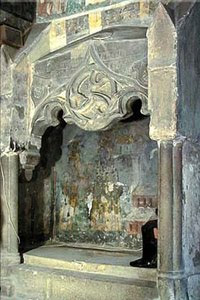Arbore Monastery is located in the northeastern part of Romania, in the Bukovina region, about 30 km from the town of Suceava. Arbore Monastery is among the famous painted monasteries in Romania and it was listed as UNESCO World Heritage Site since 1993.
The monastery was built between the 2nd of April and the 29th of August 1503, by Luca Arbore, in the village of Soloca, that he owned. He was one of the important boyars of Ştefan cel Mare, being since 1486 the gatekeeper of Suceava. He defended bravely the Suceava Fortress in 1497 against Polish attacks. Five month later, he erected the monastery, next to his private residence, meant as a family chapel and cemetery. Luca never saw the paintings of his monastery completed because he was beheaded along with two of his sons, having been falsely accused of treachery. The church was dedicated to Saint John the Baptist.
The church has a rectangular plan at the outside without a tower. The extremely elegant silhouette of the building is emphasized by the wall extension to the west by about 2,5 meters, and their union above, through an arch; originally thought as a space for the steeple, a new architectural element in Moldavia of the time.
It has remarkable fresco paintings against a predominant green background. The green is in five shadows and 47 hues combined with red, blue, yellow, pink and ochre. Unfortunately the secret of combining colors held by the painters of Arbore is now lost. However, scientists were able to identify thirty substances, including animal size, vinegar, egg, gall and honey. Restorers can now only stabilize what has been left of the frescoes. The interior paintings were seriously damaged in the 17th-18th centuries when the church remained without its roof.
The paintings were made by a team led by Dragoş Coman from Iaşi. The artist proves to be a genius: a widely-traveled man, he innovates, has a new vision different from the one of his predecessors, he succeeds in making a bold synthesis of oriental and western elements, well integrated in tradition though. Most of the paintings represent scenes taken from the Genesis and the Saints' Lives. They are delicate and vivid, whereas houses are drawn in perspective. The best preserved frescoes are found on the relatively sheltered south and west walls.
Among the most valuable scenes one may see are The Hymn of the Prayers to the Virgin, The Siege of Constantinople, The Last Judgment, The Prodigal Son and many others. The Siege of Constantinople is a syncretic representation of the attacks of Persians, Avars and Slaves upon Constantinople in 617. The Journey of the Magi, the Holy Virgin and other scenes show the painter's disposition to rocky landscape against a predominantly green background, like in the Last Judgment where he finds his own solutions to render the characters' movement fluid. In the Prayer of All Saints on the apse, Christopher, the defender against death, with Baby Jesus on his shoulder is also among the martyr saints, it is a unique and unusual image for Moldavia, influenced by the mural painting in Catholic countries.
The two heavy slabs of stone preserved near the church since the time it was painted, have fifteen small holes which used to serve as containers for the mixing of colors. Traces of pigment corresponding to the frescoes have been found in the hollows on their surface.
In the narthex, which also functions as a burial chamber, one may find the tombs of the church founders, Luca Arbore and his Polish wife, Iuliana, decorated with unusual Gothic stonework that bears a strong Polish influence. The icon screen dates from about the same time as the church itself. It is heavily encrusted with smoke, but paintings underneath are intact, preserved by the very grime which obscures them. Inside the monastery, an ethnographic museum with a rich display of the region's most valuable assets is worth visiting. The monastery was restored between 1909-1914 and 1936-1937.
Sources: Braşov Travel Guide, MarvaoGuide, CreştinOrtodox.
The Wallachian Style Portal
8 hours ago










0 comments:
Post a Comment